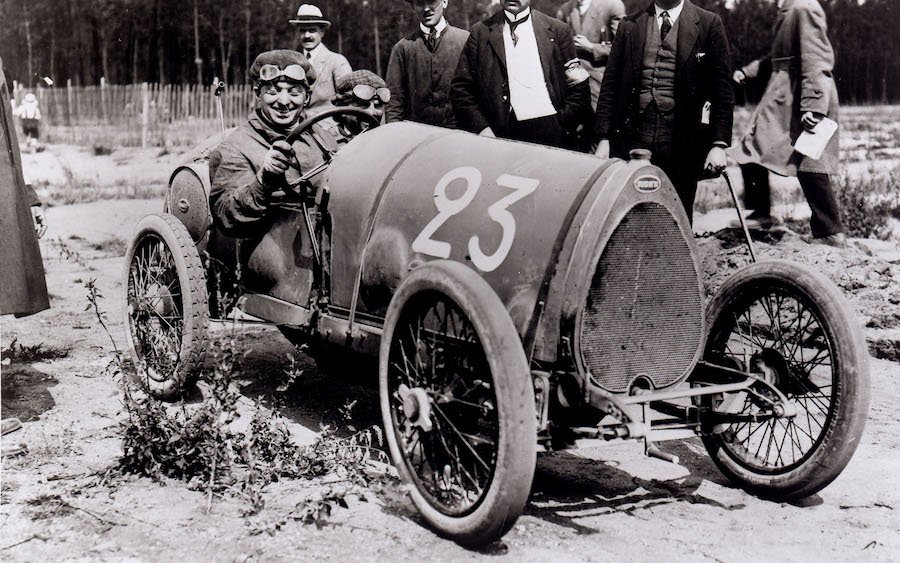The brand was founded in 1909 by the legendary Italian-born engineer Ettore Bugatti, and quickly established itself due to the revolutionary designs of its vehicles. Before creating his own car company, Bugatti designed several automobiles for De Dietrich, a French manufacturer he worked for between 1902 and 1904.
During that time, he developed the 60 CV Course Bugatti Type 5, a car powered by a humongous 12.86-liter engine that featured one ignition coil per combustion chamber, overhead valves, and hopper cooling.
It was able to produce 60 PS and was the first Bugatti-made vehicle capable of surpassing the 100 kph (62 mph barrier). The two-seater had a top speed of 120 kph (75 mph) and only two of them were manufactured between 1902 and 1903.
After leaving De Dietrich he started producing cars for his friend Emile Mathis, one of the leading car dealers in France, at that time. In 1904, under the newly founded company Hermes-Simplex, he built the 40/50 PS model, which was powered by a 7.5-liter four-cylinder engine and was able to achieve speeds of over 120 kph (75 mph).
The cars competed in several races and were produced at Societe Alsacienne de Construction Mecanique (SACM), in Graffenstaden. In the following years, he developed the Hermes-Simplex 50/60 PS models, which were powered by either an 8.5-liter or a 9-liter four-cylinder engine.
An 80/90 PS version was also produced, which had a bigger, 12-cylinder that enabled it to reach speeds of over 130 kph (81 mph). In 1906, Mathis and Bugatti parted ways, and the latter went on to produce several prototypes in collaboration with Cologne-based manufacturer Deutz AG.
A year later he was appointed Production Director at Deutz, and in early 1909 he designed the Bugatti Deutz Prinz Heinrich Type 9 C, an innovative racing car that could easily surpass 140 kph (87 mph).
The car made its first appearance at the Prinz-Heinrich-Fahrt, an 1,850 km (1150 miles) endurance race for four-seater touring cars founded by Prince Albert Wilhelm Heinrich of Prussia.
The same year Ettore Bugatti established his own brand, and returned to the famed endurance race in 1910. This time he showcased the newly designed Type 13, a lightweight car that had a much smaller, 1.4-liter, four-cylinder engine and was capable of speeds greater than 150 kph (94 mph).
After the war, he showcased the Type 35, a brand new racecar that was powered by a 2.0-liter eight-cylinder engine that delivered 95 PS and powered it to speeds of up to 190 kph (118 mph).
The car evolved through the years into the Type 35B which, despite Bugatti's loathing for forced induction, had a 2.3-liter engine that was aided by a Roots supercharger, increasing its power to 140 PS and enabling the car to go over 215 kph (133 mph). It is Bugatti's most successful racecar to this day, winning thousands of races, including the first-ever Monaco Grand Prix.
In 1929 a new race car was introduced, the Type 45. It featured a 16-cylinder engine designed by Bugatti, combining two parallel eight-cylinder units from the Type 35.
The 3.8-liter engine delivered 270 PS and could easily surpass 250 kph (155 mph) but the car was only used for short-distance and hill races, as the tires of the era were unable to cope with the high speed over extended periods.
One of Ettore Bugatti's biggest ambitions at the time was building a car that could travel at speeds of over 300 kph (186 mph).
Technical drawings and sketches from 1929 indicate that he wanted to combine the eight-cylinder engine from the Type 41 Royale with a Type 50 gearbox and create a car that would theoretically surpass that speed, but due to economic difficulties, he was never able to complete this project.
The quest of surpassing this speed was taken on by Italian entrepreneur Romano Artioli later on, who purchased the Bugatti trademark in 1987 and built one of the best super sports cars of the 1990s, the EB110.
It was powered by a 3.5-liter V12 mid-engine with five valves per combustion chamber that produced between 560 PS and 610 PS, depending on the model and development stage.
It went on to break the 300 kph (186 mph) mark in 1992 and set a new speed record at 342 kph (213 mph). A year later, the SuperSport version of the EB110 set a new top speed record at 351 kph (218 mph).
After a difficult period that saw the brand decline, it was purchased by the Volkswagen Group in 1998. Followin several years of arduous development work, the Veyron EB 16.4 became the first hyper sports car of the 2000s to achieve speeds of over 400 kph (249 mph).
The 8.0-liter 16-cylinder engine with a power output of 1,001 PS helped the Veyron break the speed record for a production car in April 2005, reaching a top speed of 408.47 kph (253.81 mph).
Eight years later, the open-top Bugatti Veyron 16.4 Grand Sport Vitesse set a new record, reaching 408.84 kph (254.04 mph).
That record was broken in 2019 by the new Chiron Super Sport 300+. The hypercar was the first car to go past the 300 mph mark, achieving a top speed of 490 kph (304 mph) thanks to the improved quad-turbocharged W16 engine that has a monstrous output of 1,600 PS.
Bugatti revealed its latest creation earlier this year, the Bolide, an extreme, track-oriented hyper sports car powered by the most capable version of the legendary W16 engine.
The output is increased to 1,850 PS and simulations indicate that its capable of reaching a top speed of well over 500 kph (311 mph) without any compromises in terms of handling and agility.
It will be interesting to see what speeds it can achieve in a real-life situation and we are looking forward to the next chapter of Bugatti's history of speed in the electric propulsion era.
Noticias relacionadas

